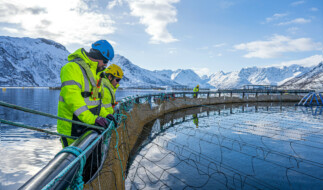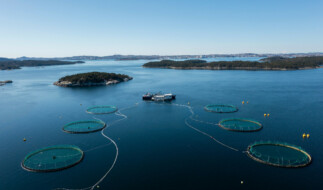It is our responsibility and commitment to avoid any impact of our operations on wild salmon populations. Keeping low levels of sea lice and avoiding escapes is key, and we are committed to continuous evolutions in our farming practices to support co-existence.
Ecosystem management
Escapes
Escape incidents rarely happen at salmon farms. However, they can occur due to unintended factors such as extreme weather events, human error, or predation. We want to avoid any risk of ecological interactions or interbreeding with wild populations or cause harm to any of our fish, so we are committed to targeting zero escapes across all our member farms.
Sea lice
Sea lice naturally occur in the ocean and have been feeding on wild salmon for millennia. However, the number of salmon present within a farm can provide the conditions for sea lice numbers to multiply. Therefore, it is essential we work to continually improve our best practices to manage sea lice and ensure they do not affect the health and sustainability of either wild salmon or the salmon our members raise.
There are two forms of sea lice of concern to the salmon farming industry: Lepeophtheirus salmonis, a salmon-specific sea lice that affects farms in Norway, the UK, and Canada; and Caligus rogercresseyi, which affects farms in Chile.
There are many different ways we are working to control sea lice numbers, including daily monitoring and following local regulations. Here we look at some of the holistic preventative methods GSI members are trialling as part of their evolving sea lice strategies. As with all operational measures, farmers work closely with development companies, vets and fish health experts to ensure the salmon’s health is maintained throughout the process, and interactions with the fish are kept to a minimum to reduce any additional stress.
Frequently asked…
Are sea lice a big issue I should be concerned by?
Sea lice are naturally-occuring tiny copepods which affect both wild and farmed salmon, but like in any farming conditions when animals are held together in a group there is a higher chance for numbers to increase and lead to higher densities. Which is why it is it is our goal to effectively manage their existence and reduce their occurrence. Firstly, all companies transparently report on sea lice numbers, and abide by strict local regulations to monitor and manage numbers as required.
Within GSI, we have an expert global fish health and welfare working group who hold regular technical workshops to share experiences on how to best manage sea lice. This includes both medicinal treatments for the farmed salmon as needed, but more specifically the development of non-medicinal approaches which create barriers around the farms.
To learn more on this topic please view our page on fish health and welfare.
Non-medicinal approaches to sea lice
Post smolt
With continuing innovation into post smolt facilities, farmers are able to reduce the time fish are in sea water, which decreases exposure to sea lice.
Digital tools
With the introduction of digital tools, we are able to predict sea lice levels in advance and work proactively to prevent possible lice outbreaks.
Sea lice skirts
Skirts are sheets of material (usually tarpaulin) that are mounted around the top portion of salmon pens. As sea lice larvae are generally found in the first few meters of water below the surface, a skirt can act as a shield, preventing sea lice within the upper part of the water from entering a salmon farm. To ensure there are no unwanted impacts on the water oxygen levels in the upper part of the pen, oxygen management is considered when using skirts.
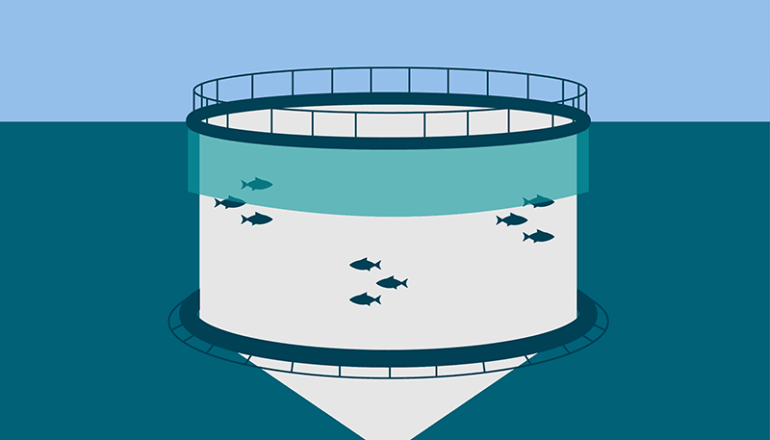
Functional Feed
Functional feeds are specifically formulated to support optimum fish health. When used in sea lice management, they are tailored to contain specific ingredients that help salmon fight off sea lice in two ways:
- By supporting natural fish defenses:
- Strengthening fish external barriers by thickening protective mucus layers on the skin.
- Boosting fish immune and inflammatory responses.
- By affecting the sea lice themselves:
- Altering sea lice development and growth.
- Decreasing sea lice ability to attach to fish.
- Reducing immune suppression caused by sea lice.
GSI is working closely with its associate members BioMar, Cargill and Skretting to share learnings and best practices on using functional feeds and the role they can play in sea lice management. In addition, GSI members are working with feed companies to continually monitor the effectiveness of functional feeds, with the aim of driving progress within the research and development.
Snorkels
Snorkels work by creating a barrier between the salmon and sea lice. A net roof fits within the salmon pen with an enclosed tube (or snorkel) at the top extending to the water surface. This technology keeps the salmon deeper in the water column and therefore, away from sea lice larvae – which tend to be found in the first few meters of water.
As salmon need to reach the surface to take air into their swim bladders, the snorkel tube design enables fish to easily reach the surface within a protected zone that keeps them separate from the sea lice.
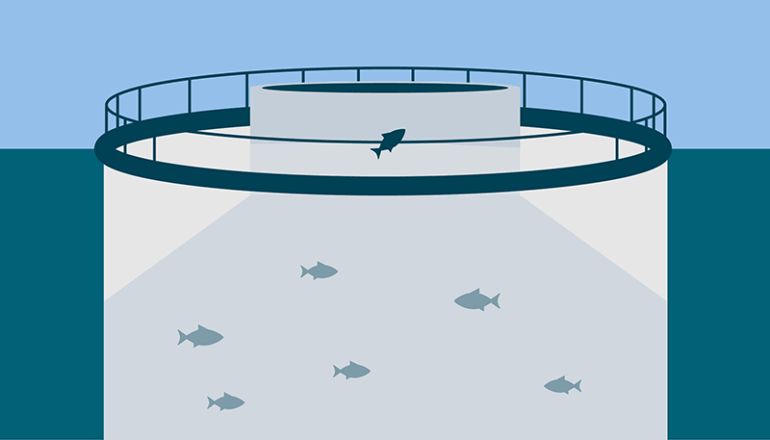
Thermal treatments (e.g. Thermolicer/Optilicer)
Sea lice have a low tolerance for sudden changes in water temperature and this sensitivity is taken advantage of by thermal treatments. A thermal treatment system is fitted to a boat or barge near to a salmon pen and fish are briefly passed through the system and bathed in lukewarm water. This temperature change kills the sea lice and the salmon are released back into the pen.
Here are the different steps for the thermal treatment process, outlined in the figure below:
- Fish enters the system
- Water is separated
- Sea water is filtered and released
- Fish passes through warmer water
- Fish travels through treatment loop
- Water surface
- Water separator for treatment water
- Fish exits the system
- Heated water is circulated to water tank for filtration, aeration and reheating
- Treatment water is pumped back into the system for re-use
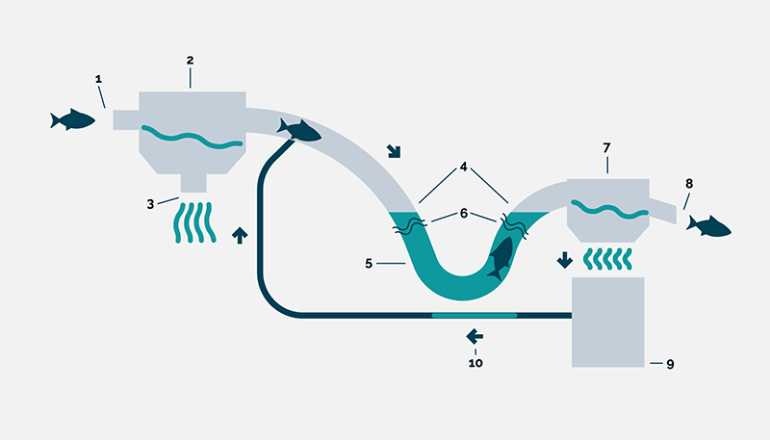
Strategic localization and treatment of sites
Through researching ocean water flow and currents, it is possible to predict how sea lice will disperse. For example, differences in water salinity between regions and farms, or water depth, can have a significant impact on lice levels and management. By using this information, farm sites can be strategically placed in those areas less likely to have high levels of sea lice.

Flushers (e.g., Hydrolicer, Flatsetsund Flusher)
Sea lice can be dislodged by jets of water (like a shower). This is taken advantage of by moving salmon through a system with water jets to flush off lice. A flusher system is fitted to a boat or barge near to salmon pens, and fish are briefly passed through the flusher. Detached lice are collected and then salmon are returned back into the pen.
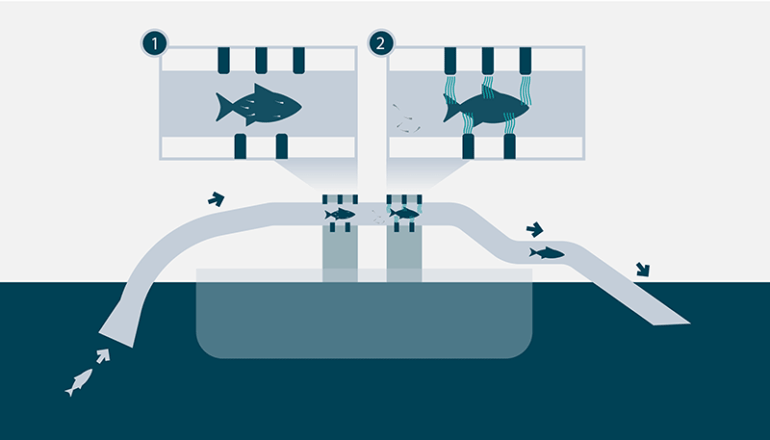
Lasers
A camera and laser system placed in a fish pen detects sea lice on the salmon, and once detected, a laser pulses directly at the louse. The louse is hit and killed by the laser – removing it from the salmon. The system operates within the pen 24/7.
As salmon have mirror-like skin, the salmon itself is not harmed as the skin reflects the laser beam away.
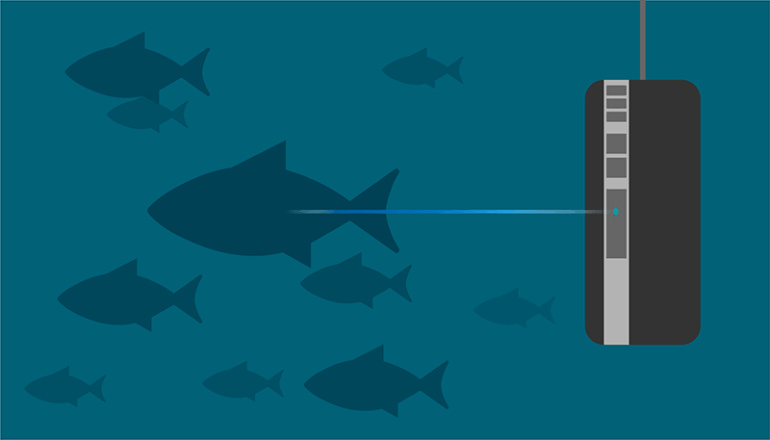
Sea lice traps
This method is similar to a wasp catcher. By placing traps in the water around salmon farms, they attract lice away from the pens and into the traps, therefore removing them. To attract as many sea lice as possible, some traps have flashing lights which has been found to attract sea lice.
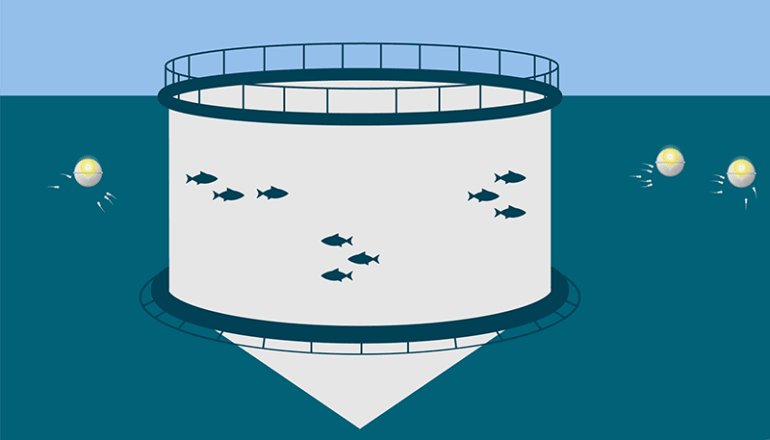
Cleaner fish
There are several species of fish, including ballan wrasse and lumpfish, which naturally eat sea lice. These fish are introduced to salmon pens to eat sea lice off the salmon. This is a biological approach to sea lice management, and there are research projects underway to identify additional species that may work as cleaner fish, and to ensure the health and welfare of the cleaner fish are also maintained in this process.

Deep lights / deep feeding
By placing lights or feeding systems deep in the pen (~10 meters below the surface), the salmon are attracted to swim and feed in the deeper water of the pen. As sea lice generally remain in the surface waters, these approaches entice the salmon away from the sea lice.

Bubble curtains
A device is placed around the bottom circumference of the salmon pen and releases a line of air bubbles that rise from the bottom to the surface of the pen. The air bubbles create a barrier/wall and sea lice are deterred from entering the salmon pen.
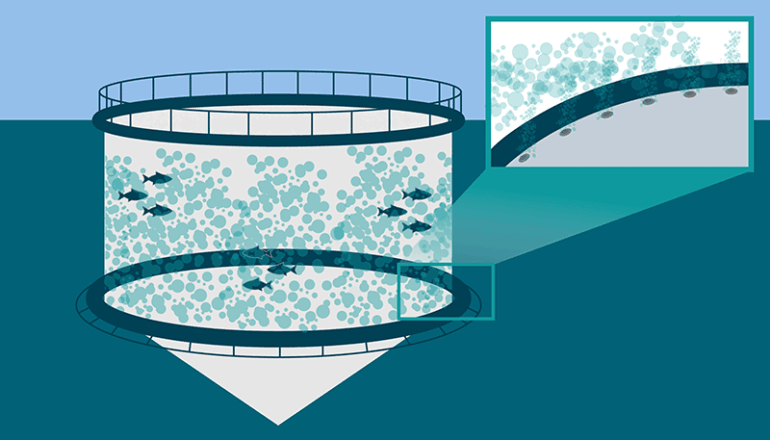
H2O2 (hydrogen peroxide)
H202 is known to temporarily paralyze sea lice, causing them to fall off the salmon and reduce their ability to re-attach. Salmon are temporarily exposed to H2O2 – either in a well boat or a specifically designed tarpaulin where H2O2 is added. After this, seawater is flushed through the pen to dilute the H2O2, breaking it down rapidly into water and oxygen.
H2O2 is a registered medicine, meaning its use is recorded and monitored. However, as H2O2 dilutes to water and oxygen, it has zero toxicity and zero persistence in the environment and is therefore, considered as a non-medicinal approach to sea lice management.
Freshwater treatments
Sea lice are sensitive to fresh water (i.e., not sea water) and generally cannot survive when water salinity is very low. Freshwater treatments exploit this and through temporarily exposing salmon to fresh water, the sea lice detach and can then be removed.
In the wild, salmon migrate to freshwater to spawn and this change in water removes any sea lice. To ensure sea lice do not develop resistance to fresh water and cause any disruption to this natural process, the use of this process is carefully monitored and managed.
Continued innovation
While there has been ongoing progress in the management of escapes and sea lice, there is still a lot more we can do. Within GSI, our dedicated fish health and welfare taskforce continues to discuss and share evolutions in best-practices to help ensure farms can co-exist alongside wild populations for many years to come.
